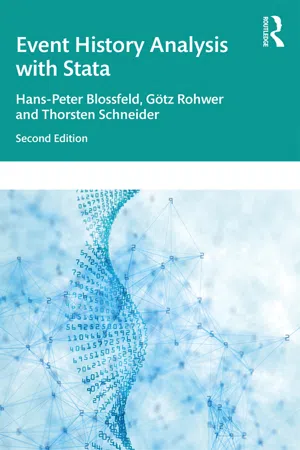
Event History Analysis With Stata
2nd Edition
- 352 pages
- English
- ePUB (mobile friendly)
- Available on iOS & Android
Event History Analysis With Stata
2nd Edition
About this book
Nowadays, event history analysis can draw on a well-established set of statistical tools for the description and causal analysis of event history data. The second edition of Event History Analysis with Stata provides an updated introduction to event history modeling, along with many instructive Stata examples.
Using the latest Stata software, each of these practical examples develops a research question, refers to useful substantive background information, gives a short exposition of the underlying statistical concepts, describes the organization of the input data and the application of the statistical Stata procedures, and assists the reader in performing a substantive interpretation of the obtained results. Emphasising the strengths and limitations of event history model techniques in each field of application, this book demonstrates that event history models provide a useful approach with which to uncover causal relationships or to map out a system of causal relations. It demonstrates how long-term processes can be studied and how changing context information on the micro, meso, and macro levels can be integrated easily into a dynamic analysis of longitudinal data.
Event History Analysis with Stata is an invaluable resource for both novice students and researchers who need an introductory textbook and experienced researchers (from sociology, economics, political science, pedagogy, psychology, or demography) who are looking for a practical handbook for their research.
Frequently asked questions
- Essential is ideal for learners and professionals who enjoy exploring a wide range of subjects. Access the Essential Library with 800,000+ trusted titles and best-sellers across business, personal growth, and the humanities. Includes unlimited reading time and Standard Read Aloud voice.
- Complete: Perfect for advanced learners and researchers needing full, unrestricted access. Unlock 1.4M+ books across hundreds of subjects, including academic and specialized titles. The Complete Plan also includes advanced features like Premium Read Aloud and Research Assistant.
Please note we cannot support devices running on iOS 13 and Android 7 or earlier. Learn more about using the app.
Information
1
Introduction
- Chapter 2 describes event history data sets and their organization. It also shows how to use such data sets with Stata.
- Chapter 3 discusses basic nonparametric methods used to describe event history data, mainly the life table and the Kaplan-Meier (product-limit) estimation methods as well as cumulative incidence functions, and finally an appropriate nonparametric method for processes with competing risks.
- Chapter 4 deals with the basic exponential transition rate model. Although this very simple model is almost never appropriate in practical applications, it serves as an important starting point for all other transition rate models.
- Chapter 5 describes a simple generalization of the basic exponential model, called the piecewise constant exponential model. In our view, this is one of the most useful models for empirical research, and we devote a full chapter to discussing it.
- Chapter 6 discusses time-dependent covariates. The examples are restricted to exponential and piecewise exponential models, but the topic–and part of the discussion–is far more general. In particular, we introduce the problem of how to model parallel and interdependent processes.
- Chapter 7 introduces a variety of models with a parametrically specified duration-dependent transition rate, in particular the Gompertz–Makeham, Weibull, log-logistic, and log-normal models.
- Chapter 8 discusses the question of goodness-of-fit checks for parametric transition rate models. In particular, the chapter describes simple graphical checks based on transformed survivor functions and generalized residuals.
- Chapter 9 introduces basic and advanced semiparametric transition rate models based on an estimation approach proposed by D. R. Cox (1972). The advanced part on Cox models describes fixed effects models for multiepisode data.
- Chapter 10 discusses problems of model specification, in particular, transition rate models with unobserved heterogeneity. The discussion on specifying more than one error term on the same level is mainly critical, and examples are restricted to using a gamma mixing distribution. This chapter also provides a short introduction to transition rate models with random coefficients in a multilevel framework.
- Chapter 11 by Brendan Halpin introduces sequence analysis as a complementary alternative to event history analysis, with exploratory and descriptive advantages. Sequence analysis focuses on longitudinal data such as life course trajectories as wholes and calculates distances between sequences. These distances can be used to create data-based typologies using cluster analysis to calculate distance to theoretically or empirically defined reference sequences, to compare trajectory diversity across variables such as cohort, to compare similarity of dyadic pairs of sequences such as couples’ time use, and so on.
- The Appendix contains many exercises designed to help the reader gain a deeper understanding of the (basic) concepts, more familiarity with how to handle event history data and estimation commands in Stata, and greater skill in estimating the results.
1.1 Causal modeling and observation plans
Table of contents
- Cover
- Half Title
- Title
- Copyright
- Contents
- Preface
- Acknowledgments
- 1 Introduction
- 2 Event history data structures
- 3 Nonparametric descriptive methods
- 4 Exponential transition rate models
- 5 Piecewise constant exponential models
- 6 Exponential models with time-dependent covariates
- 7 Parametric models of time dependence
- 8 Methods to check parametric assumptions
- 9 Semiparametric transition rate models
- 10 Problems of model specification
- 11 Introduction to sequence analysis
- Appendix: exercises
- References
- About the authors
- Index